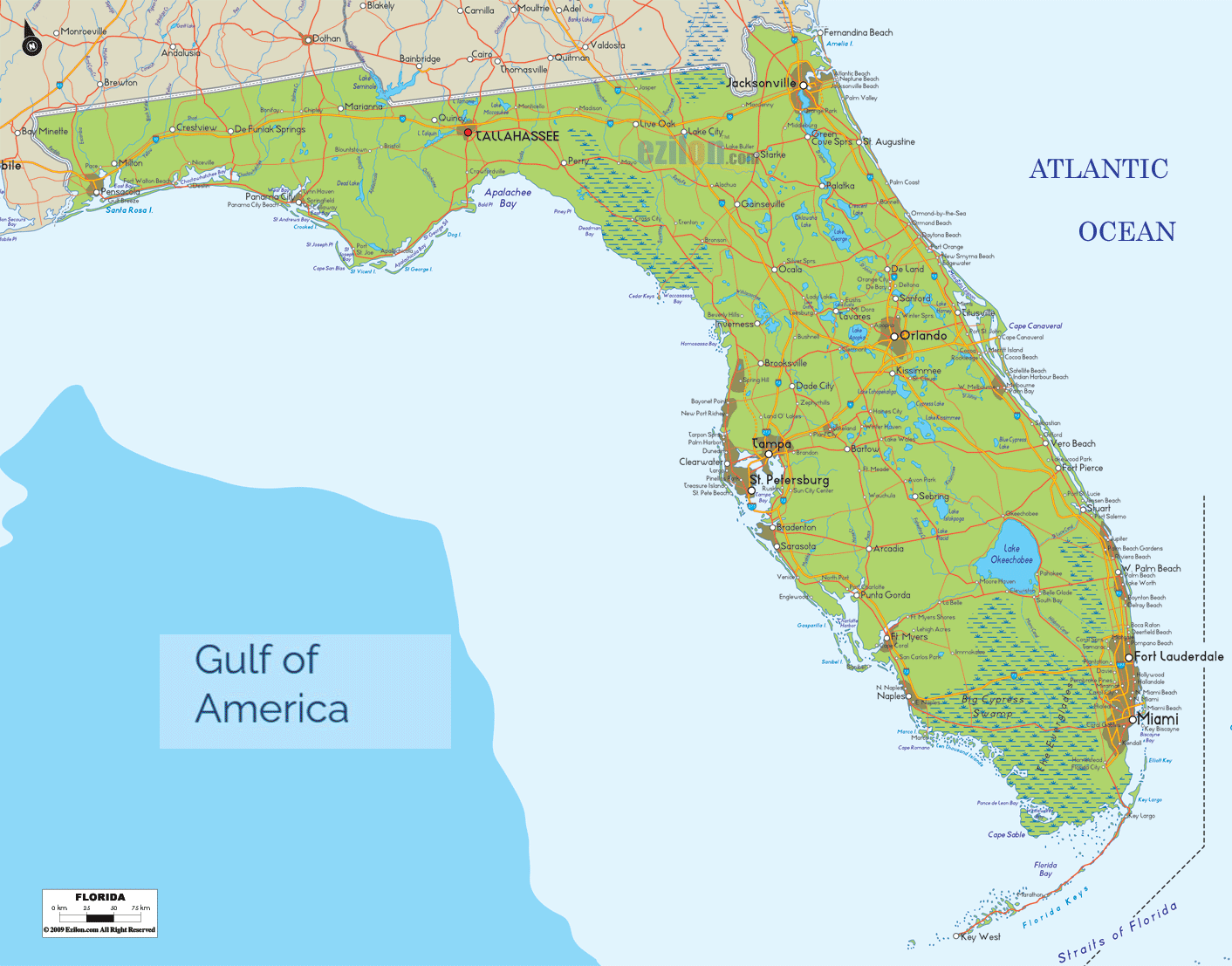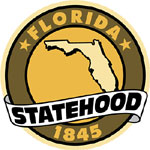

Description: The Physical map of Florida State USA showing major geographical features such as rivers, lakes, borders with atlantic ocean, gulf of Mexico and other topography or land formations.
 When you gaze upon the expansive physical map of Florida, the Sunshine State reveals itself in an intricate play of waterways, landforms, and ecosystems. This detailed cartographic guide offers an intimate view of Florida's natural topography - spelling out a rich narrative across its Northern, Southern, Eastern, Western, and Central regions. The intent here is not merely to provide directions or to denote locations but to help you fully grasp the intricate weave of rivers, lakes, hills, and other geographical elements that shape Florida.
When you gaze upon the expansive physical map of Florida, the Sunshine State reveals itself in an intricate play of waterways, landforms, and ecosystems. This detailed cartographic guide offers an intimate view of Florida's natural topography - spelling out a rich narrative across its Northern, Southern, Eastern, Western, and Central regions. The intent here is not merely to provide directions or to denote locations but to help you fully grasp the intricate weave of rivers, lakes, hills, and other geographical elements that shape Florida.
The southern portion of Florida, as depicted on this detailed map, is a study of water and subtropical ecosystems. Dominating this area is the famed Everglades National Park. The park is an immense wilderness of wetlands, marshes, and mangroves, and the map offers a detailed view of its elaborate network of estuaries, canals, and waterways.
Winding its way through the southern landscape is the Miami River, often overlooked but critical in draining the Everglades and supplying water to local ecosystems. The map clarifies that this region is defined by its water bodies, with Lake Okeechobee as its crowning glory. This lake, one of the largest in the United States, is outlined vividly, illustrating its many feeder rivers and outlets, such as the Caloosahatchee River, that extend like veins across the region.
Contrary to its southern counterpart, Northern Florida is highlighted on the map by an ensemble of springs and rivers that carve their paths through a terrain of limestone and sandy hills. The Suwannee River, with its headwaters in the Okefenokee Swamp, is one of the key features.
You will notice the St. Johns River, one of the few rivers in the United States that flow north, extending its tendrils through multiple counties. Adding to the hydrological orchestra are the Ichetucknee and Santa Fe Rivers, highlighted prominently on the map.
Each river is not just a line on the map but signifies a larger watershed that supports diverse ecosystems and offers myriad recreational opportunities. The northern region also houses the Osceola National Forest, a coniferous swamp forest that is an essential habitat for numerous species.
In a specific area in Florida, where the land meets the Atlantic Ocean, they carefully measure and keep track of the coastline. A key feature here is the Indian River, an elongated lagoon that runs parallel to the eastern coast and is a significant estuarine sanctuary.
The map meticulously traces the river's course, indicating where it interacts with tributaries like the Banana River. It also showcases the famous archipelago of the Florida Keys, a coral cay formation that stretches like a string of pearls off the southeastern tip. Regarding coral barrier reefs, the Florida Reef stands alone on the mainland of the United States. It is known for its unique geography and ecological importance.
The Western edge of Florida, facing the Gulf of Mexico, has its geographical features. The map provides an intricate view of the panhandle region, showcasing rivers like the Apalachicola and the Ochlockonee.
The Choctawhatchee Bay plays a crucial role in shaping the ecology of the western coastline. Florida's panhandle is unique in its topography, with sandy ridges and limestone terrains, all well-represented on the map.
As you move towards Central Florida, the map offers a mix of the state's aquatic and terrestrial features. The Kissimmee River, which flows into Lake Okeechobee, is significant both for its role in the regional water cycle and as a vital corridor for wildlife. Not far from it is Lake George, Florida's second-largest lake, a significant waypoint on the map for its size and role as a drainage basin for the St. Johns River.
This area also hosts a myriad of smaller lakes, such as Lake Tohopekaliga and Lake Apopka, which are also clearly marked. Their locations are essential for geographical orientation and understanding how Central Florida's water systems interlink.
The detailed physical map of Florida is a visual and educational treat, providing a sophisticated understanding of the state's complex geographical anatomy. Each river, lake, hill, and coastline is carefully etched to offer a holistic view of Florida's natural landscape, inviting you to explore further and appreciate the diverse ecosystems that make up this extraordinary state.
Whether you are a student, a nature enthusiast, a traveler, or simply someone curious about Florida's physical geography, this map is an indispensable tool for a comprehensive understanding.

Counties and Road Map of Florida
Counties and Road map and map image of Florida.

Regional Directory of Canada
Information and guide about Canada and website listing.

Regional Directory of United States of America
Information and guide about United States of America and websites with American topics.

Regional Directory of Europe
Information and guide about Europe and websites with European topics.

Regional Directory of Australia
Information and guide about Australia and websites with Australian topics.